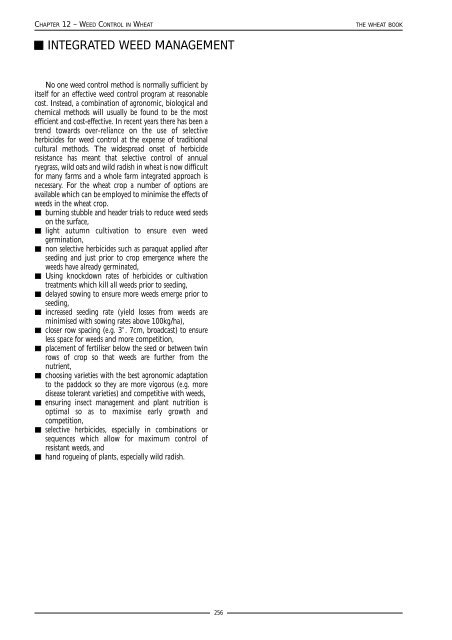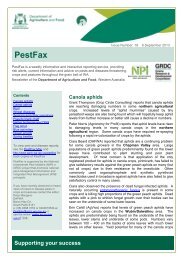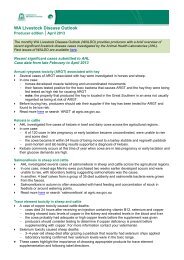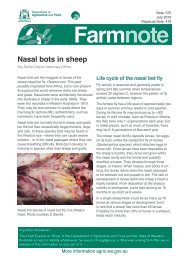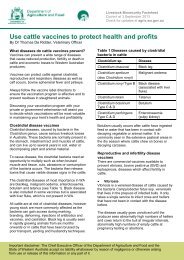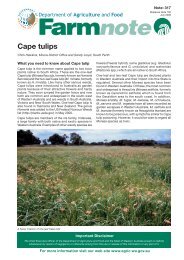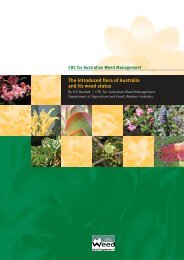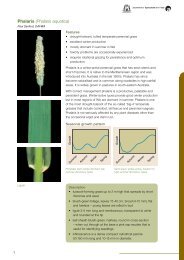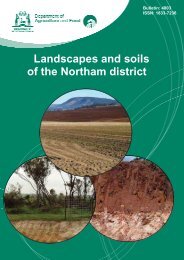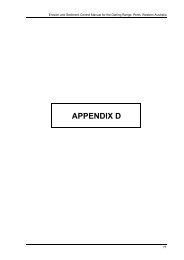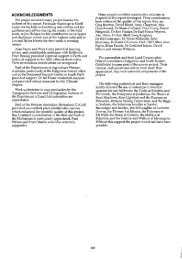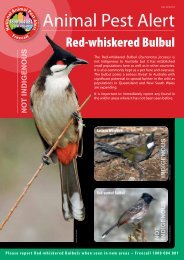The wheat book : principles and practice - Department of Agriculture ...
The wheat book : principles and practice - Department of Agriculture ...
The wheat book : principles and practice - Department of Agriculture ...
Create successful ePaper yourself
Turn your PDF publications into a flip-book with our unique Google optimized e-Paper software.
CHAPTER 12 – WEED CONTROL IN WHEAT THE WHEAT BOOK<br />
INTEGRATED WEED MANAGEMENT<br />
No one weed control method is normally sufficient by<br />
itself for an effective weed control program at reasonable<br />
cost. Instead, a combination <strong>of</strong> agronomic, biological <strong>and</strong><br />
chemical methods will usually be found to be the most<br />
efficient <strong>and</strong> cost-effective. In recent years there has been a<br />
trend towards over-reliance on the use <strong>of</strong> selective<br />
herbicides for weed control at the expense <strong>of</strong> traditional<br />
cultural methods. <strong>The</strong> widespread onset <strong>of</strong> herbicide<br />
resistance has meant that selective control <strong>of</strong> annual<br />
ryegrass, wild oats <strong>and</strong> wild radish in <strong>wheat</strong> is now difficult<br />
for many farms <strong>and</strong> a whole farm integrated approach is<br />
necessary. For the <strong>wheat</strong> crop a number <strong>of</strong> options are<br />
available which can be employed to minimise the effects <strong>of</strong><br />
weeds in the <strong>wheat</strong> crop.<br />
burning stubble <strong>and</strong> header trials to reduce weed seeds<br />
on the surface,<br />
light autumn cultivation to ensure even weed<br />
germination,<br />
non selective herbicides such as paraquat applied after<br />
seeding <strong>and</strong> just prior to crop emergence where the<br />
weeds have already germinated,<br />
Using knockdown rates <strong>of</strong> herbicides or cultivation<br />
treatments which kill all weeds prior to seeding,<br />
delayed sowing to ensure more weeds emerge prior to<br />
seeding,<br />
increased seeding rate (yield losses from weeds are<br />
minimised with sowing rates above 100kg/ha),<br />
closer row spacing (e.g. 3” . 7cm, broadcast) to ensure<br />
less space for weeds <strong>and</strong> more competition,<br />
placement <strong>of</strong> fertiliser below the seed or between twin<br />
rows <strong>of</strong> crop so that weeds are further from the<br />
nutrient,<br />
choosing varieties with the best agronomic adaptation<br />
to the paddock so they are more vigorous (e.g. more<br />
disease tolerant varieties) <strong>and</strong> competitive with weeds,<br />
ensuring insect management <strong>and</strong> plant nutrition is<br />
optimal so as to maximise early growth <strong>and</strong><br />
competition,<br />
selective herbicides, especially in combinations or<br />
sequences which allow for maximum control <strong>of</strong><br />
resistant weeds, <strong>and</strong><br />
h<strong>and</strong> rogueing <strong>of</strong> plants, especially wild radish.<br />
256


